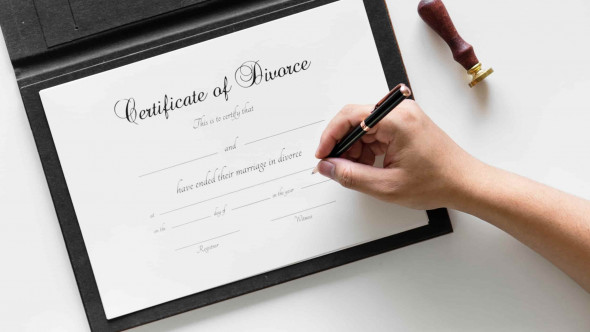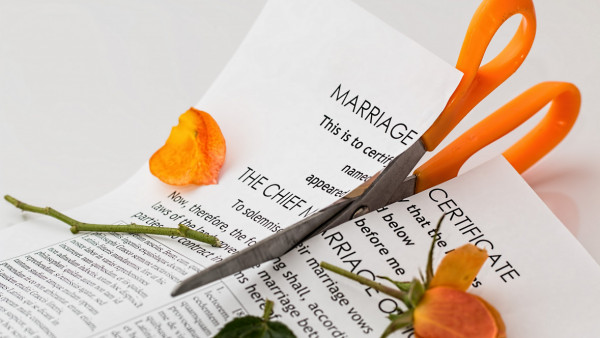No-fault divorce update
New divorce legislation came into effect on 6 April 2022 that has changed the divorce process.
It’s no longer possible to contest a divorce.
So, your spouse won’t be able to hold up your divorce. However, you’ll need to wait a minimum of 26 weeks before your divorce can be finalised.
For more information, read our guide: No fault divorce: Everything you need to know.
Petitioning for divorce
When you file for divorce, your spouse will be sent a copy of your application and an Acknowledgement of Service form.
As the respondent, it’s their role to return this form stating whether they agree to the divorce or wish to contest it.
Technically, they must return the Acknowledgement of Service form before the court will move your divorce forward. But this is something of a formality.
In practice, your spouse up to eight days to respond. If they don’t, you can apply to the court for a decree nisi, which states that the court sees no reason why the divorce shouldn’t be granted.
Difficulties with this process
Your spouse has up to eight days to respond before you can continue your divorce without their consent. But it can still cause a problem if they won’t sign the divorce papers.
Before the court will push ahead with your divorce application, they must be sure that:
-
Your spouse has received notice of the divorce proceedings
-
Your spouse has had the chance to respond
If your spouse won’t co-operate with you, this can be difficult to prove. So, unless your spouse returns the Acknowledgement of Service form, you won’t be able to move on to the next stage of your divorce.
However, while this situation is far from ideal, you’ll still be able to get divorced by showing the court that you’ve made every reasonable effort to tell your spouse about the proceedings.
You can do this by following these five steps.
Step 1 – Check your spouse has received the divorce papers
The first thing you should do is check that your spouse has received the divorce papers. There may be a simple reason why they haven’t retuned the Acknowledgement of Service form.For example, they might be away on holiday, or the form may have got lost in the post.
Try to get in touch with them as soon as possible to ask if they’ve received the divorce papers. They may tell you that they haven’t received the papers, in which case you can apply for the papers to be sent again.
Ideally, your spouse will then return the Acknowledgment of Service form, allowing you to move on to the next stage of the divorce.
Step 2 – Apply to the court for a deemed service
Unfortunately, getting through to your spouse isn’t always easy when you’re separated.
If your spouse won’t talk to you, there may be evidence that they’ve seen the divorce petition, even if they haven't signed the Acknowledgement of Service.
For example, they may have previously sent you a text or an email saying that they’ve received the divorce papers.
You can file this as evidence at court and ask for an order of 'deemed service'. This means that the court will declare that your spouse has seen the petition, despite not receiving their Acknowledgement of Service.
A judge will decide whether the evidence you provide is enough proof that your spouse has received the divorce petition.
If you’re successful, the court will be able to move on with the next stage of your divorce.
Step 3 – Send the divorce papers to your spouse directly
The judge may decide that the evidence you provide isn’t strong enough to approve your deemed service order.
If your deemed service application is refused, your next option is to physically serve your spouse with the divorce papers.
You can then use this as evidence to the court that your spouse is aware of the divorce proceedings.
Instruct a process server
In many cases, the best way of doing this is through a process server.
A process server is someone that your divorce solicitor can instruct to physically deliver the divorce papers to your spouse for you.
While you could deliver the divorce papers yourself, a process server will be more effective at convincing the court that your spouse is aware of proceedings.
In some cases, this is because you may not actually know where your spouse is.
Experienced process servers have access to databases that will help them to track your spouse down, wherever they are. So, if your spouse has changed address, moved abroad, or even been sent to prison, the process server will probably be able to find them and serve them with the divorce papers.
Even if you do know how to find your spouse, it might still be best to instruct a process server to deliver the divorce papers for you.
This is because once your spouse has been served with the divorce papers, the process server will submit a certificate of service to prove to the court that your spouse has received the divorce petition.
This should satisfy the court that your spouse has received notice of proceedings, allowing you to move on to the next stage of the divorce.
Step 4 – Use an alternative way of serving the divorce papers
While process servers can usually track people down, they’re not always successful.
If personal service doesn’t work, you can apply to the court for permission to use an alternative way of serving the petition.
For example, you may think your spouse is more likely to receive the petition at another place other than their home. This could be their parents’ house, their new partner's house, or even a relative or friend.
Alternatively, you could do something like placing an advert in a local newspaper, but the court must be satisfied that this is likely to be seen by your spouse.
Step 5 – Apply for a dispensed service
If all else fails, you may be able get divorced without your spouse’s consent by applying for a dispensed service.
A dispensed service means that the court will allow you to proceed with your divorce despite not having the consent of your spouse.
To be successful in your application, you must show the court that you’ve made all reasonable enquiries to find your spouse and serve them with the petition. So, you’ll need detailed records of all the attempts you’ve made to trace them.
Speak to a divorce solicitor
Going through a divorce can be a stressful experience at the best of times. But when your spouse won’t sign the divorce papers, it can be particularly frustrating.
Following these five steps should convince the court that you’ve tried everything to notify your spouse about the divorce, meaning you’ll be able to get divorced without their consent.
But the process can be complicated, as well as time consuming and expensive.
If you need help because your spouse won’t sign the divorce papers, you should speak to a divorce solicitor who can guide you and provide support.
The Law Superstore lets you compare divorce solicitors near you – completely free.






